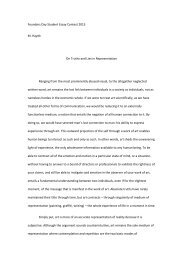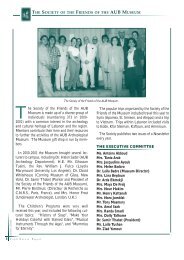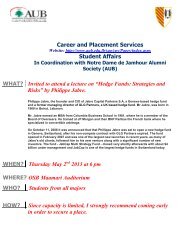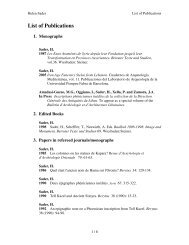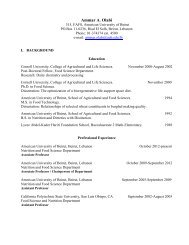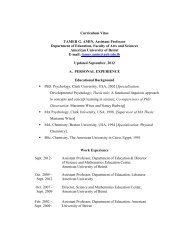The IX t h Makassed Medical Congress - American University of Beirut
The IX t h Makassed Medical Congress - American University of Beirut
The IX t h Makassed Medical Congress - American University of Beirut
Create successful ePaper yourself
Turn your PDF publications into a flip-book with our unique Google optimized e-Paper software.
Recent trials examining the need for revascularization have concentrated on patients who could<br />
be managed medically or with revascularization after a complete work-up including angiography.<br />
<strong>The</strong> COURAGE trial and the BARI 2D trial both showed equivalence for medical therapy or<br />
interventions. <strong>The</strong> question <strong>of</strong> percutaneous intervention or surgery as the revascularization<br />
choice for patients who are judged to require it has been investigated in a number <strong>of</strong> trials<br />
ranging from the EAST and BARI to SYNTAX. All <strong>of</strong> these trials, starting with balloon angioplasty and<br />
moving to drug eluting stents, have shown relative equivalence <strong>of</strong> the two techniques for the<br />
patients selected. Of most current interest is the longer-term follow-up <strong>of</strong> the SYNTAX trial which<br />
investigated patients with extensive three-vessel disease and left main disease and which to date<br />
shows no major difference in survival but an advantage for surgery in the avoidance <strong>of</strong> repeat<br />
interventions. Most importantly, this trial demonstrated angiographic and clinical predictors <strong>of</strong> a<br />
gradient <strong>of</strong> outcomes based on the extent <strong>of</strong> disease.<br />
This is helpful in selecting patients; however, significant gaps still exist. Pertinent to the first question<br />
(should revascularization be done?), the currently proposed trial, ISCHEMIA, will investigate<br />
patients who have significantly more ischemia than those in the BARI 2D and COURAGE trials<br />
and will randomize them prior to coronary arteriography to either continued medical therapy<br />
or angiography with planned intervention. Pertinent to the second question, the group with<br />
greatest survival differential favoring surgery, i.e. patients with diabetes, has been investigated in<br />
the FREEDOM trial. This study <strong>of</strong> 1,900 patients completed enrollment in 2009 and will be the most<br />
definitive comparison <strong>of</strong> diabetic patients undergoing drug eluting stenting or bypass surgery.<br />
<strong>The</strong> advances in medical therapy, coronary intervention, and surgery have all made the outlook<br />
for patients with stable ischemic heart disease much brighter than it was at the dawn <strong>of</strong> the<br />
interventional cardiology era. Better understanding <strong>of</strong> the comparative effectiveness <strong>of</strong> these<br />
approaches will help guide therapy in the future.<br />
Mitral Regurgitation<br />
TAVI WHERE DO WE STAND IN 2010?<br />
Samir R. Kapadia, MD<br />
E. Murat Tuzcu, MD<br />
1. Mitral regurgitation (MR) is a significant problem, and the number <strong>of</strong> patients with MR is<br />
growing with increase in patients with congestive heart failure. Surgical correction <strong>of</strong> MR with<br />
repair techniques yields better results than valve replacement, however, a significant number<br />
<strong>of</strong> patients undergo valve replacement even in the current era.<br />
2. Various percutaneous approaches to mitral valve repair are under preclinical and clinical<br />
investigation and show great promise for the future. <strong>The</strong>se approaches are predominantly<br />
based on established surgical strategies.<br />
3. Different percutaneous techniques provide specific advantages depending on the<br />
anatomical and functional characteristics <strong>of</strong> mitral regurgitation. Selection <strong>of</strong> the appropriate<br />
technique/s for each individual patient will ultimately determine the success <strong>of</strong> these emerging<br />
technologies.<br />
4. Integration <strong>of</strong> established imaging modalities both in and out <strong>of</strong> the catheterization laboratory<br />
is critical for safety and efficacy <strong>of</strong> percutaneous repair technologies. <strong>The</strong> development <strong>of</strong><br />
emerging imaging modalities will likely play a role in the future <strong>of</strong> percutaneous technologies.<br />
5. Evaluation <strong>of</strong> new percutaneous devices poses a significant challenge because these<br />
devices have to be compared to surgical options that may have different expectations in<br />
the overall management <strong>of</strong> the patient. It is likely that percutaneous techniques will have a<br />
complimentary role to surgery.<br />
81






